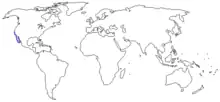Shovelnose guitarfish
The shovelnose guitarfish, Pseudobatos productus, is a ray in the family Rhinobatidae.[2][3] It becomes mature at an estimated seven to eight years old. Males are between 90–100 cm (35–39 in) long, while females are around 99 cm (39 in) at that age.[4] The ray can live up to 11 years, and full-grown sizes are around 120 cm (47 in) for males, and females reach 137 cm (54 in).[5] They range from central California south to the Gulf of California.[1] Morphological and genetic variations occur in the mitochondrial DNA in those found in the Gulf of California, evidencing their isolation from the rest. Because of this, the conservation of this species must be carefully managed to preserve the biological diversity.[6] The shovelnose is considered to be a primitively developed ray, with many features of both sharks and rays.
| Shovelnose guitarfish | |
|---|---|
 | |
| Dorsal view | |
 | |
| Ventral view | |
| Scientific classification | |
| Domain: | Eukaryota |
| Kingdom: | Animalia |
| Phylum: | Chordata |
| Class: | Chondrichthyes |
| Superorder: | Batoidea |
| Order: | Rhinopristiformes |
| Family: | Rhinobatidae |
| Genus: | Pseudobatos |
| Species: | P. productus |
| Binomial name | |
| Pseudobatos productus (Ayres, 1854) | |
 | |
| Range of P. productus | |
| Synonyms | |
|
Rhinobatos productus | |
Pseudobatos productus has magnetic particles in its vestibular receptors, and the magnetic particles are believed to be exogenous in origin. The magnetic particles' spatial arrangement may aid in the sensitivity of the receptors to movements.[7]
The visual system of the shovelnose is more extensive and developed than other Elasmobranchii, with multiple large projections connecting to the brain. Almost the entire dorsal and ventral hypothalamus is connected to the visual system, but still maintains a similar lack of differentiation as with sharks.[8]
The shovelnose guitarfish was first considered to be a shark because of its dorsal fins' shape.
Human interaction
Recreation
This species can be caught from the surf, within shallow California waters. Sand crabs, various bivalves such as mussels, and other live or dead bait are recommended for catching the fish.[9]
As food
The common cuts of meat used from the shovelnose guitarfish are the trunk, tail, and loin, mostly from mature individuals. It has been referred to as "shark steak" within markets, and is usually served fried; with other iterations such as cocktails and kebabs being prepared. It is sold as fish and chips in Santa Barbara, California on piers. Dried specimens of all sizes are also frequently sold in shell shops throughout central to Baja California.[4][10]
References
- Farrugia, T.J.; Márquez-Farías, F.; Freedman, R.M.; Lowe, C.G.; Smith, W.D. & Bizzarro, J.J. (2016). "Pseudobatos productus". IUCN Red List of Threatened Species. 2016: e.T60171A104004394. doi:10.2305/IUCN.UK.2016-3.RLTS.T60171A104004394.en. Retrieved 12 November 2021.
- "Rhinobatos productus". Integrated Taxonomic Information System. Retrieved 24 January 2006.
- Froese, Rainer; Pauly, Daniel (eds.) (2005). "Rhinobatos productus" in FishBase. August 2005 version.
- Timmons, M and Bray, R. Age, growth, and sexual maturity of shovelnose guitarfish, Rhinobatos productus. Fishery Bulletin 95:349–359 (1997).
- Timmons, M Bray RN (2004). "Age, growth, and sexual maturity of shovelnose guitarfish, Rhinobatos productus (Ayres)". Fishery Bulletin. 95 (2): 349–359.
- J. Sandoval-Castillo; A. Rocha-Olivares; C. Villavicencio-Garayzar; E. Balart (2004). "Cryptic isolation of Gulf of California shovelnose guitarfish evidenced by mitochondrial DNA" (PDF). Marine Biology. 145 (5): 983–988. doi:10.1007/s00227-004-1378-7. S2CID 86751007. Archived from the original (PDF) on 2012-04-25.
- D.P. O’Leary; J. Vilches-Troya; R.F. Dunn & A. Campos-Muñoz (1981). "Magnets in guitarfish vestibular receptors". Cellular and Molecular Life Sciences. 37 (1): 86–88. doi:10.1007/BF01965587. PMID 7202681. S2CID 19317589.
- Ebbesson, S.O.E. & Meyer, D.L. (1980). "The visual system of the guitar fish (Rhinobatos productus)". Cell and Tissue Research. 206 (2): 243–250. doi:10.1007/bf00232768. PMID 7388890. S2CID 9273148.
- "California Marine Sportfish Identification: Sharks", California Department of Fish and Wildlife. Retrieved February 26, 2021.
- "Shovelnose guitarfish", Sea Grant California. Retrieved February 26, 2021.

